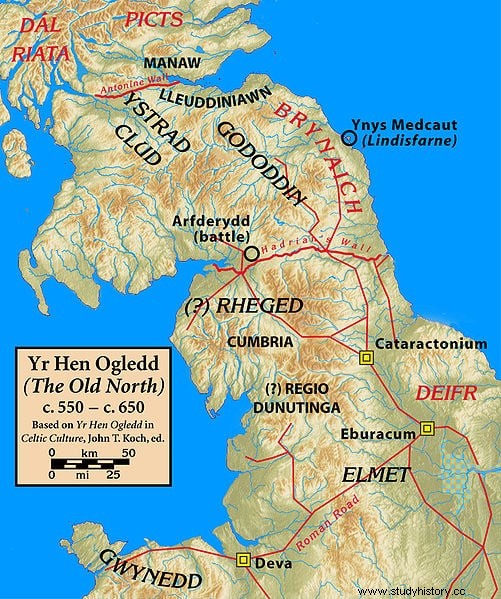The kingdom of Rheged was a post-Roman fall Celtic kingdom whose status researchers based on speculation only, until early 2017.
He appears abundantly in early British poetry, where both Nennius and the bard Taliesin associate him with a king named Urien in the second half of the sixth century. Also in the first historical sources, which place it in an area between the south of Scotland and the north of England, probably Westmoreland or Cumbria. However, its exact location had always been a mystery.
Most historians accept that it must have had its main center in the city of Carlisle, thus relating it to the Civitas Carvetiorum , the Roman enclave in the territory of the Carvetii on which the modern city stands today. But there is no archaeological evidence to support this theory.

The excavations carried out in the fortress of Trusty’s Hill , in the Scottish council of Dumfries and Galloway, yielded new and interesting evidence that contradicts the traditional hypothesis. By the way, Trusty's Hill is also one of the strange British glass fortresses we talked about in a previous article.
The tasks, which began in 2012, were initially motivated by the presence of Pictish symbols (the group of peoples who inhabited the north and east of Scotland since the end of the Iron Age) engraved on the rock of the fortress, and whose uniqueness lies in that they are much further south than where they are usually found. What they found, rather than validate the presence of Picts in Galloway, suggests that the engravings are related to a royal enclave around 600 AD
According to the researchers, archaeological evidence suggests that Galloway may indeed have been the heart of the lost kingdom of Rheged. during the British Dark Ages. And not only that, but one of the main kingdoms of the time in the north.
Excavations revealed that in the decades around the year 600 the top of the hill was reinforced with a stone wall lined with wood. Additional defenses and enclosures were added to the lower areas, and Trusty's Hill was transformed into a type of fortress similar to the regal ones of the early Middle Ages.

Remains were also found of a workshop that produced high-quality metal objects in gold, silver, bronze and iron that spread through the trade network that linked western Britain with Ireland and continental Europe.
Analysis of the Pictish symbols places them, without any doubt according to archaeologists, as early medieval carvings that combine local traditions with innovations brought from across the English Channel. Its meaning, however, remains unknown, as the Pictish symbols remain undeciphered. What is clear, comparing them with others found in Scotland, such as those from Edinburgh Castle, is their royal character.
Archaeologists conclude that Trusty's Hill was a place of religious, cultural and political innovation, and the main political center of the Rheged kingdom. Nearby Whithorn would have been the religious center, Urien its most famous king, and Taliesin its chief poet.
The kingdom was short-lived, from its origins in the early 5th century until it was deliberately destroyed and annexed by Northumbria around 638 AD. The fire of the place was the one that probably gave rise to the phenomenon known as a vitrified fortress.
The results of GUARD Archeology's research were published in the book The Lost Dark Age Kingdom of Rheged (Ronan Toolis and Christopher Bowles).
